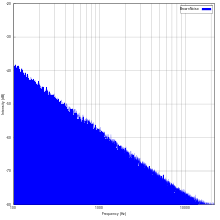Brownian noise
In science, Brownian noise (![]()
| Colors of noise |
|---|
| White |
| Pink |
| Red (Brownian) |
| Grey |

Explanation
The graphic representation of the sound signal mimics a Brownian pattern. Its spectral density is inversely proportional to f 2, meaning it has more energy at lower frequencies, even more so than pink noise. It decreases in power by 6 dB per octave (20 dB per decade) and, when heard, has a "damped" or "soft" quality compared to white and pink noise. The sound is a low roar resembling a waterfall or heavy rainfall. See also violet noise, which is a 6 dB increase per octave.
Strictly, Brownian motion has a Gaussian probability distribution, but "red noise" could apply to any signal with the 1/f 2 frequency spectrum.
Power spectrum
A Brownian motion, also called a Wiener process, is obtained as the integral of a white noise signal:
meaning that Brownian motion is the integral of the white noise , whose power spectral density is flat:[1]
Note that here denotes the Fourier transform, and is a constant. An important property of this transform is that the derivative of any distribution transforms as[2]
from which we can conclude that the power spectrum of Brownian noise is
An individual Brownian motion trajectory presents a spectrum , where the amplitude is a random variable, even in the limit of an infinitely long trajectory [3].
Production
Brown noise can be produced by integrating white noise.[4][5] That is, whereas (digital) white noise can be produced by randomly choosing each sample independently, Brown noise can be produced by adding a random offset to each sample to obtain the next one. A leaky integrator might be used in audio applications to ensure the signal does not "wander off". Note that while the first sample is random across the entire range that the sound sample can take on, the remaining offsets from there on are a tenth or thereabouts, leaving room for the signal to bounce around.
Sample
References
- Gardiner, C. W. Handbook of stochastic methods. Berlin: Springer Verlag.
- Barnes, J. A. & Allan, D. W. (1966). "A statistical model of flicker noise". Proceedings of the IEEE. 54 (2): 176–178. doi:10.1109/proc.1966.4630. and references therein
- Krapf, Diego; Marinari, Enzo; Metzler, Ralf; Oshanin, Gleb; Xu, Xinran; Squarcini, Alessio (2018-02-09). "Power spectral density of a single Brownian trajectory: what one can and cannot learn from it". New Journal of Physics. 20 (2): 023029. arXiv:1801.02986. Bibcode:2018NJPh...20b3029K. doi:10.1088/1367-2630/aaa67c.
- "Integral of White noise". 2005.
- Bourke, Paul (October 1998). "Generating noise with different power spectra laws".